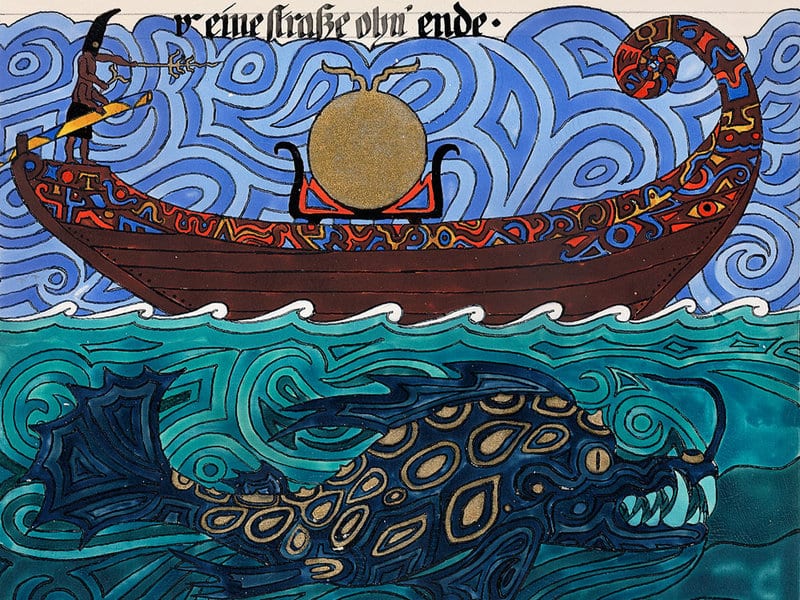
Active imagination in the psychology of Carl Jung is a therapeutic technique we can use when a conflict between the conscious mind and the unconscious is unresolvable through dreams or analysis. Jung’s Red Book illustrates the best account of active imagination. His life and work show us what active imagination can do for a human soul.
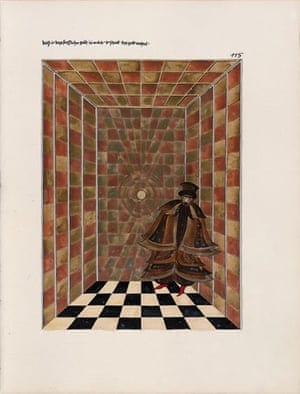 This kind of unresolved conflict always starts with an underlying unconscious pressure, pressure which eventually manifests as symptoms, such as anxiety or depression. I put technique in italics because I think the word can be confusing when it comes to active imagination.
This kind of unresolved conflict always starts with an underlying unconscious pressure, pressure which eventually manifests as symptoms, such as anxiety or depression. I put technique in italics because I think the word can be confusing when it comes to active imagination.
A technique implies that you can sit down and do active imagination like you could sit down and read a book or something. I don’t think you can’t do that.
In the first place, active imagination is a way to get at that unconscious pressure which I mentioned above. We need that element of tension in the psyche as a starting point for active imagination.
Remember that Jung discovered active imagination during his four-year confrontation with the unconscious. Jung’s psychic atmosphere was highly charged during this time of his life. He needed relief from that unbearable pressure, lest he commit suicide.
To repeat, that kind of psychic pressure manifests as a symptom, such as anxiety or depression, or some other form of mental disturbance. Without that unconscious material trying to push its way through the threshold of consciousness, we’re really just playing around.
Table of Contents - Jump To Section
Free Form Post Disclaimer
In an effort to get my content on the site, I’ve decided to post articles that I have already written, rather than try to rewrite everything. I’ll do that in a book someday. So for now, read on and please forgive me if some of this lacks flow. The information is relevant and will help you understand the work, regardless of my free-styling method…
Essential Elements of Active Imagination
During my initial training, I saw many active imagination seminars offered, but I was always suspicious of them. How can you do a seminar on active imagination?
 Going into a group setting and contriving an experience of active imagination is just that: contrived, artificial, and unnatural. Most of what I have seen, even in the training candidate seminars, approach active imagination as something you can just do whenever.
Going into a group setting and contriving an experience of active imagination is just that: contrived, artificial, and unnatural. Most of what I have seen, even in the training candidate seminars, approach active imagination as something you can just do whenever.
The dreams, however, could not help me over my feeling of disorientation. On the contrary, I lived as if under constant inner pressure. At times this became so strong that I suspected there was some psychic disturbance in myself.
C.G. Jung, Memories, Dreams, Reflections
Active imagination starts with an unsettled problem, with pressure from the unconscious. So, if that pressure is lacking, then you don’t have the underlying energy necessary for active imagination.
Based on what Jung said about active imagination, these are what I consider the essential elements of active imagination:
- Pressure
- Disorientation
- Confusion
- Uncertainty
- An insoluble problem
- Lack of dream material
Jung’s Discovery of Active Imagination
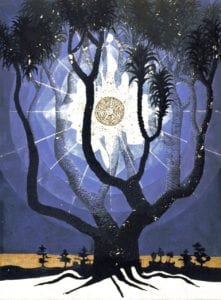 As I said, Jung discovered active imagination during his confrontation with the unconscious. After his break with Freud, he had reached a point in his life where his dreams no longer spoke to him and he could not analyze what was happening to him. He wondered if he was losing it.
As I said, Jung discovered active imagination during his confrontation with the unconscious. After his break with Freud, he had reached a point in his life where his dreams no longer spoke to him and he could not analyze what was happening to him. He wondered if he was losing it.
It raised a lot of inferior feelings in me, but I knew of no better way. Towards autumn I felt that the pressure that had seemed to be within me was not there anymore but in the air. The air actually seemed darker than before. It was just as if it were no longer a psychological situation in which I was involved, but a real one, and that sense became more and more weighty.
He was in a state of profound despair. The anxiety he was suffering forced him to consider suicide. He thought to himself, “I have to get to the bottom of this.”
This was the whole basis of Jung’s Red Book. He was in crisis and fraught with angst and fear. He got to the bottom of all that through a waking dialogue, essentially taking place in the dream world. And if you read the Red Book along with his Collected Works, you’ll see exactly from where his psychology emerged.
He speaks about this process in Memories, Dreams, and Reflections and in the book quoted above, Seminar 1925 Introduction to Jungian Psychology.
Is Active Imagination Like Lucid Dreaming?
A man once asked me what Jung’s thoughts on lucid dreaming were. I can’t say that Jung had a specific view about lucid dreaming. I’ve never seen anything about it in his work. We use active imagination when we or an analysand reach a point where the dreams stop or slow down and “analysis” of the intolerable situation no longer alleviates suffering.
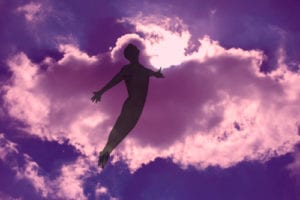 To me, active imagination sounds similar to lucid dreaming, with the significant exception that you are not in any way trying to force the dream into one solution or another. You have your voice and the inner image has its voice. Together you reach a solution.
To me, active imagination sounds similar to lucid dreaming, with the significant exception that you are not in any way trying to force the dream into one solution or another. You have your voice and the inner image has its voice. Together you reach a solution.
Jung also called this the transcendent function. The essay appears in Collected Works, volume 5: The Structure and Dynamics of the Psyche.
The idea is that if you reach this solution with that inner other, the tension releases and your awareness reaches a new level. I know from experience that it works.
Everything I have seen on lucid dreaming revolves around your ability to control the dream. I mean, people talk about flying and doing all kinds of stunts. My guess is that you’re not even dreaming if you can do that. You’re either playing in the field of unproductive fantasy or fooling your ego with the misconception that you are so powerful that you can control your dreams.
Active and Passive Fantasy in Jungian Psychology
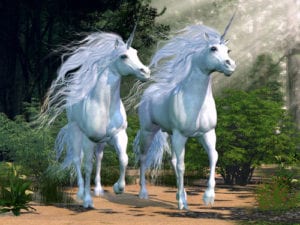 The concept of fantasy is important to Jung’s psychology. Maybe it’s a bit of a side note to go into it here, but I think it’s relevant because the more you understand psyche, the better you understand yourself. Also, I think it will lend some insight into the difference between active imagination and lucid dreaming.
The concept of fantasy is important to Jung’s psychology. Maybe it’s a bit of a side note to go into it here, but I think it’s relevant because the more you understand psyche, the better you understand yourself. Also, I think it will lend some insight into the difference between active imagination and lucid dreaming.
In active imagination, we learn to engage our mental imagery, what Jung called fantasy.
Before he coined the term active imagination, Jung used the words active fantasy, as opposed to passive fantasy, to describe the process. Both refer to mental imagery, but they are very different in terms of their productivity. Keep in mind that we’re talking about operational definitions here. This is what Jung means when he uses these words. People forget this and get caught up in semantics.
Let’s say that someone tells me, “I saw two unicorns in my active imagination today”. I say, “okay, then what happened?” If that person tells me that nothing else happened, then that’s not active fantasy, it’s passive. It just appeared or the person conjured it.
The main difference between active and passive fantasy is:
- the position and attitude of the ego-consciousness in relation to the fantasy
- do you respond or watch?
- the resultant effect of the fantasy on the ego
- has something changed you or not?
Basic Principles of Jung in Relation to Fantasy Images
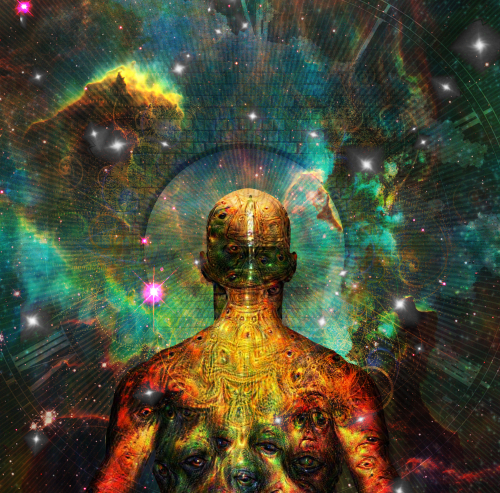 Before going into the differences between active and passive fantasy, it’s important to know some basic premises of Jung’s psychology, so that you have a point of reference.
Before going into the differences between active and passive fantasy, it’s important to know some basic premises of Jung’s psychology, so that you have a point of reference.
-
- The Unconscious is an objective, self-existing reality that autonomously acts on and affects the ego.
- Consciousness is a field that exists outside of ego-consciousness and the ego is embedded in this field.
- See Jung’s essay, Spirit and Life (CW 8) for an elaboration of psyche and the emergence of the world as image.
- Consciousness, both cosmically and individually, develops and evolves only through the integration of unconscious contents, i.e., by adding something new to the field.
Also note that when Jung uses the word fantasy, he means it in terms of its Greek word origin:
Phantasia: imagination or appearance
Imagination implies the “action of imagining or making an image” and appearance, “something which simply manifests itself”.
Here, the difference between imagination and appearance is the difference between active and passive fantasy, something we’ll look at below.
The Development of Consciousness: Our Divine Mission
For Jung, the development and evolution of consciousness was the ultimate meaning and purpose of human existence. He considered that purpose a divine mission, meaning that the development of consciousness is a goal which extends beyond our individual ego-goals.
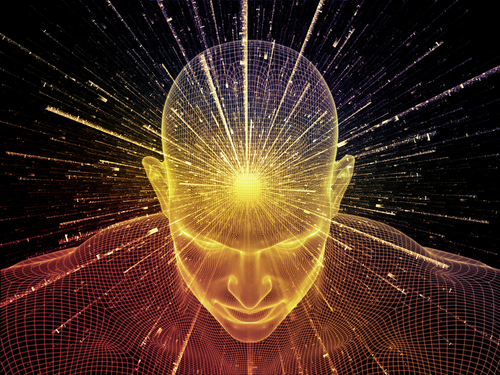 I’m sure you’ll recognize at least part of this quote below (bolded):
I’m sure you’ll recognize at least part of this quote below (bolded):
[M]an’s task is … to become conscious of the contents that press upward from the unconscious. Neither should he persist in his unconsciousness, nor remain identical with the unconscious elements of his being, thus evading his destiny, which is to create more and more consciousness. As far as we can discern, the sole purpose of human existence is to kindle a light in the darkness of mere being. It may even be assumed that just as the unconscious affects us, so the increase in our consciousness affects the unconscious.C.G. Jung, Memories, Dreams, Reflections
As I said, Consciousness (or anything in the process of development) can only develop (or expand) when something new is added to it. That something new can only come from something which was previously unknown, and that unknown something emerges from what Jung called the unconscious.
Remember that Jung integrated what he learned from his conversations with his inner figures. He brought something new into his awareness.
Jung’s Operational Definition of Fantasy (Mental Imagery)
In an interview with Richard Evans, here’s what Jung had to say about fantasies and mental imagery in general:
When you observe the world you see people, you see houses, you see the sky, you see tangible objects. But when you observe yourself within, you see moving images, a world of images, generally known as fantasies …
C.G. Jung Speaking, page 302
A World Within
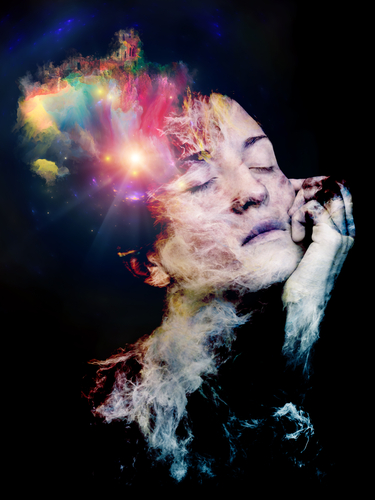 In particular, Jung was referring to the manifest world within, as opposed to the phenomenal world without. Both worlds have a reality which affects us.
In particular, Jung was referring to the manifest world within, as opposed to the phenomenal world without. Both worlds have a reality which affects us.
Close your eyes, relax, and turn your gaze inward. You see that your mind runs on its own. You can see images, hear dialogues and other sounds, or, experience emotions that are not necessarily triggered by anything which you are presently sensing coming in from the external world.
That autonomous activity is the chitta vritta of which Yoga speaks – the spontaneous activity of the mindstuff – and the very same activity out of which dreams and fantasies emerge.
All of that fantastical mindstuff, infinitely playing itself out below the threshold of consciousness, isn’t nothing. It’s something. Furthermore, it is something which has both manifest and latent meaning, hence the value Jung placed on fantasy.
Unfortunately, many people pay little or no attention to it or simplistically consider it “mindless chatter”, and thus, miss the possibility of its contribution to the development of consciousness.
Active and Passive Fantasy in the Lexicon of Jung
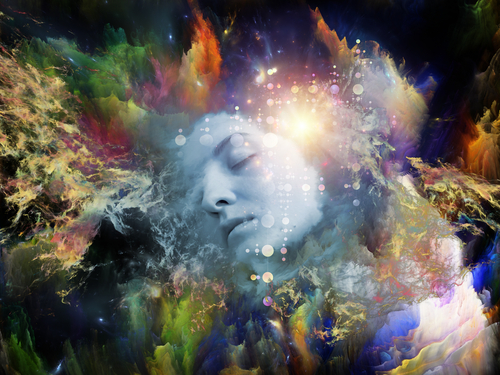 Sometimes this mindstuff comes through as powerful fantasies.
Sometimes this mindstuff comes through as powerful fantasies.
When Jung gets down to defining active and passive fantasy, he’s referring to those particular fantasies which have attained enough energetic potential to push through the threshold of consciousness in the form of a definitive image, i.e., not just those random flashes of mindstuff, but rather something which holds us in arrest.
(see Jung’s essay in CW, vol 8, On Psychic Energy for more about Jung’s conception of energy, thresholds, and energetic potential)
These kinds of fantasies assume a sort of visionary quality (which, btw, does not necessarily occur in the form of a visual image, for example, it can also be auditory).
Below is what Jung said about active and passive fantasy in Collected Works, vol 6. I will flesh out what it means for anyone who doesn’t immediately get it:
from C.G. Collected Works, vol 6 par. 712, Psychological Types
We can distinguish between active and passive fantasy. Active fantasies are the product of intuition i.e., they are evoked by an attitude directed to the perception of unconscious contents, as a result of which the libido immediately invests all the elements emerging from the unconscious and, by association with parallel material, brings them into clear focus in visual form.
Passive fantasies appear in visual form at the outset, neither preceded nor accompanied by intuitive expectation, the attitude of the subject being wholly passive.
How Your Attitude Affects Active Imagination
 By intuition, he means that particular function of consciousness which perceives from within as opposed to sensory perception.
By intuition, he means that particular function of consciousness which perceives from within as opposed to sensory perception.
By attitude, he means introversion instead of extroversion. More particularly, he means willed introversion – something like a receptive, meditative state. Active fantasy begins with a feeling that something is up, so to speak. A strange angst or mood, for example.
We direct our awareness toward that raw feeling and then let the voice or image of that feeling emerge. Hopefully, a dialogue or or more imagery comes through. That’s what Jung means when he says:
the libido immediately invests all the elements emerging from the unconscious and, by association with parallel material, brings them into clear focus in visual form.
I say more about this when I talk about turning the power of your senses inward.
Examples of Passive and Active Fantasy
Passive Fantasy
 As an example of passive fantasy, he refers to the Biblical visions of Paul and Peter, both of whose visions suddenly erupted into consciousness, as if they just came out of nowhere.
As an example of passive fantasy, he refers to the Biblical visions of Paul and Peter, both of whose visions suddenly erupted into consciousness, as if they just came out of nowhere.
However, it’s not out of nowhere. Passive fantasies erupt as a compensation for an attitude that is too one-sided, which is why Jung said that passive fantasy “often bears the stamp of morbidity”. By morbidity, he just means something starkly opposed to one’s conscious attitude.
In both cases above, the passive fantasy resulted in a conversion of the two men (from Jewish to Christian), supposedly imposed upon them by the visions.
Conversion doesn’t create anything new; it is just a change in form or the swinging of the pendulum from one side to the other, what Jung referred to as enantiodromia.
Jung was not interested in conversion because it does not offer any real healing. Jung was interested transformation, specifically though the integration of unconscious contents.
Active Fantasy (eventually Active Imagination)
We can integrate what comes in from the unconscious through an attitude of willed introversion and a readiness to perceive what is below the threshold (intuition). Only the integration of unconscious contents results in the development of consciousness, which brings us to active fantasy.
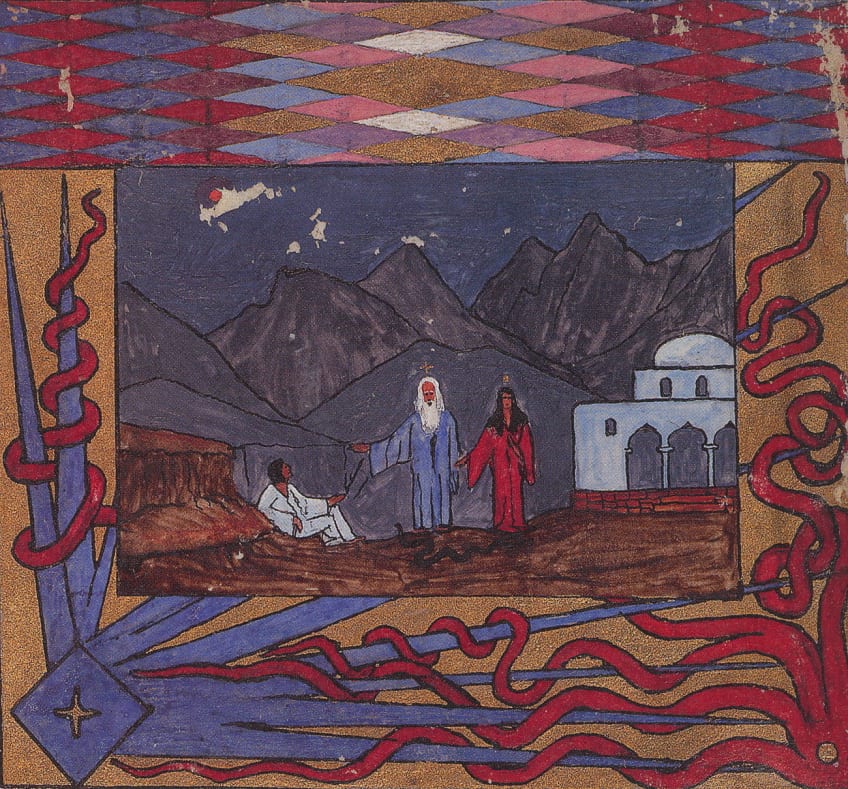 Active fantasy requires the positive participation of ego-consciousness, that is, an attitude where the ego actively engages the fantasy vision
Active fantasy requires the positive participation of ego-consciousness, that is, an attitude where the ego actively engages the fantasy vision
…for here the conscious and the unconscious personality of the subject flow together into a common product in which both are united. Such a fantasy can be the highest expression of the unity of a man’s individuality, and it may even create that individuality by giving perfect expression to its unity.
C.G. Collected Works, vol 6 par. 714, Psychological Types
Jung called active fantasy “one of the highest forms of psychic activity” because of the potential it has for “creating more consciousness”.
Again, the best example of active fantasy would be Jung’s experiences which he recorded in the Red Book. Those experiences not only changed is life, they are the foundation of his perspective on human psychology.
Jung describes conversations in the The Red Book
Philemon and other figures of my fantasies brought home to me the crucial insight that there are things in the psyche which I do not produce, but which produce themselves and have their own life.
Philemon represented a force which was not myself. In my fantasies I held conversations with him, and he said things which I had not consciously thought. For I observed clearly that it was he who spoke, not I.
He said I treated thoughts as if I generated them myself, but in his view thoughts were like animals in the forest, or people in a room, or birds in the air, and added, “If you should see people in a room, you would not think that you had made those people, or that you were responsible for them.”
It was he who taught me psychic objectivity, the reality of the psyche. Through him the distinction was clarified between myself and the object of my thought. He confronted me in an objective manner, and I understood that there is something in me which can say things that I do not know and do not intend, things which may even be directed against me
This objective reality of the psyche – that is where both mythological and dream imagery comes from to begin with. The idea is, that through willed introversion one can actually consciously sink down into the dreaming dimension.
Maybe you have had the experience of waking up from a dream and falling back into it again. That’s the idea here. That dream goes on, whether you are awake or sleeping. It’s happening beneath the surface of your consciousness.
Listening to the Inner Voice
Again, we’re free-forming. This section comes from an answer to a question I received on Quora.
 A man once asked how one learns to listen to inner voices in the way that Jung did in the Red Book.
A man once asked how one learns to listen to inner voices in the way that Jung did in the Red Book.
You learn to listen to the Self by “cultivating the art of conversing with oneself.” The art of conversing with oneself begins with some kind of powerful state of mind, whether that state of mind be psychological suffering or aesthetic arrest.
In Jung’s case, it started with suffering. As he once said,
A psychoneurosis must be understood, ultimately, as the suffering of a soul which has not discovered its meaning.
I use this particular quote from Jung because the Red Book was borne out of Jung’s own suffering. The Red Book is the story of Jung’s discovery of his meaning – a meaning which eventually flowered into his understanding of the reality of the psyche, and the psychology which emerged around that understanding.
More on Active Imagination in the Red Book
In order to understand how to listen for the Self in the way that Jung did, let’s start with looking at what the Red Book is. First, it is an account of Jung’s confrontation with the unconscious and his realization of the self-existing reality of the psyche. By self-existing reality I mean that the inner world happens to us in the same way as the external world happens to us. The dialogues in the Red Book are between Jung and his inner figures.
 To get a better idea of what this may look like in practice, see what Jung described in The Red Book when he enters the Desert and is forced to reckon with his barren interior.
To get a better idea of what this may look like in practice, see what Jung described in The Red Book when he enters the Desert and is forced to reckon with his barren interior.
Did you not see that when your creative force turned to the world, how the dead things moved under it and through it, how they grew and prospered, and how your thoughts flowed in rich rivers? If your creative force now turns to the place of the soul, you will see how your soul becomes green and how its field bears wonderful fruit.
Red Book, page 236. Jung speaking.
Active Imagination and Illumination of the Inner World
When humans became consciously aware that the world was, the energy of that awareness animated everything in existence. The same thing happens when our awareness is directed inward. That attention makes the barren inner world green again. That’s the meaning of reviving the Wasteland.
At first, our inner world appears to be nothing but random thoughts, flashing images, and memories, but if we stay with this process, we will penetrate the personal layer of the unconscious into complexes, fears, and childhood memories – and beyond that, we can penetrate the archetypal layer as Jung did in The Red Book.
And not only is our interior world illuminated when we turn toward it, but it is also extraordinarily interactive, as if it wants us to regard and engage it.
Jung’s Descent into Darkness
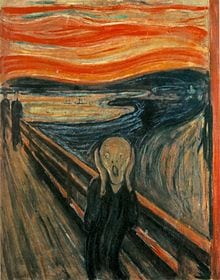 How did he discover this inner world which is inhabited by inner figures? Through his own psychological suffering. His suffering started out just like anyone else’s: a profound psychological crisis in his life. He was about 39 years old. His relationship with his closest colleague, Freud, had just blown apart; and, he had resigned all of his professional posts. All of the psychic energy which had once been channeled into his professional life had nowhere to go, and this caused a terrible neurosis in him.
How did he discover this inner world which is inhabited by inner figures? Through his own psychological suffering. His suffering started out just like anyone else’s: a profound psychological crisis in his life. He was about 39 years old. His relationship with his closest colleague, Freud, had just blown apart; and, he had resigned all of his professional posts. All of the psychic energy which had once been channeled into his professional life had nowhere to go, and this caused a terrible neurosis in him.
During this time Jung suffered from intense anxiety, fear, worthlessness, and depression. Everything he thought he was had crumbled. He called it his “great period of uncertainty”.
I lived as if under constant inner pressure. At times this became so strong that I suspected there was some psychic disturbance in myself.
His dreams were not relieving this pressure, so he took it onto himself to try and get to the core of the feeling itself. This feeling of inner pressure is key to learning how to listen to the Self.
I make this point because it’s an important aspect in the process of coming into contact with the reality of the inner world. It almost always starts with a profound feeling-toned pressure state.
Take anxiety or depression, for example. It feels a certain way. As Jung said, sometimes no account of why? can resolve it. In these cases, you have to get to the raw, energetic core of the mood or state of mind. As I explain in my article Anxiety and Depression: a Jungian Perspective.
Active Imagination: The Process
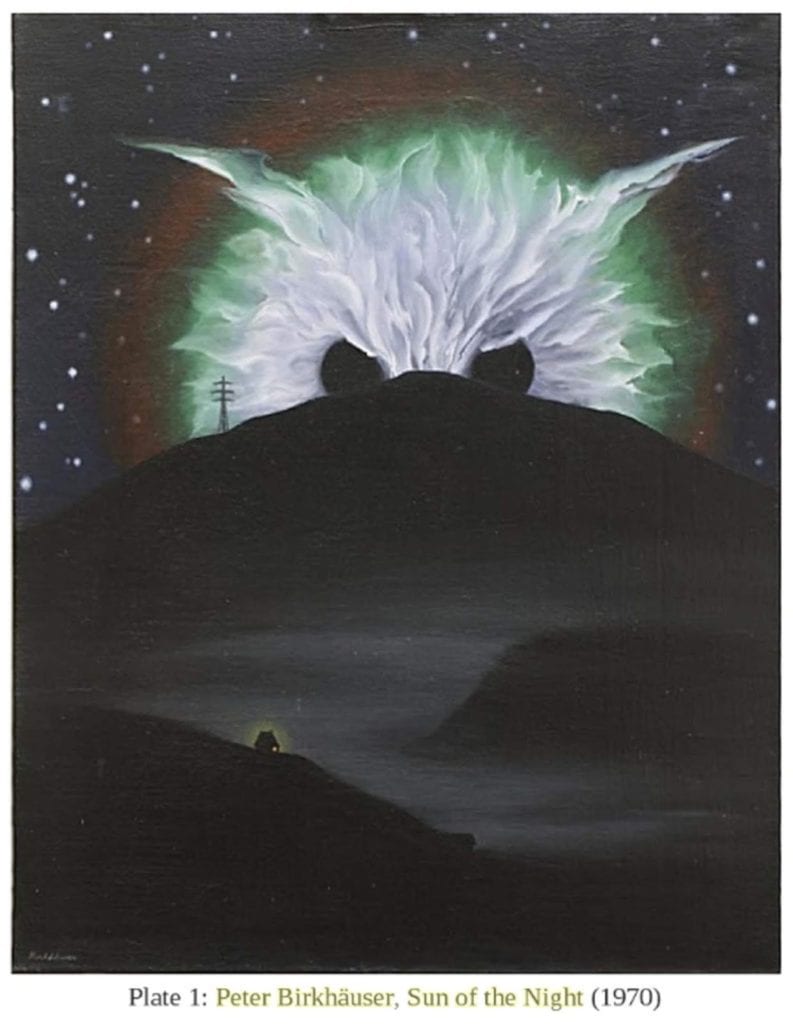 Active imagination is grounded in the idea that our psychic processes will inherently produce images of themselves.
Active imagination is grounded in the idea that our psychic processes will inherently produce images of themselves.
You start with an overwhelming feeling or emotion and then sit with it. If you sit with it long enough and move beyond your typical internal dialogue or other ideas about it, then eventually you reach a point where all you have is the tension of the that raw emotion of feeling. If you stay with that tension long enough, it will eventually form an image with which you can interact.
You get to the core of these states through an intentional act of introversion, something like meditation. You have to start with the mood itself. If depression feels dark, then enter that feeling of darkness. If anxiety feels like fear, then enter the feeling of that fear. Don’t attach to any external meaning for your feeling, for example lost jobs, broken relationships, or bad childhoods. Move past that.
What you’re trying to do is harness the raw energy that’s behind the anxiety or depression. Behind all of our symptoms is the numinous experience. Remember that Jung said “the gods have become diseases”. Anxiety and depression from this perspective is an inner calling from the gods within.
Once you can reach that raw energy state you have to sit with it. Now, there’s a tremendous amount of tension in this raw energy, and, it can be quite difficult to bear it. Don’t get pulled back into blaming some external cause. Stay with the tension of that raw energy.
Willed Introversion and Active Imagination
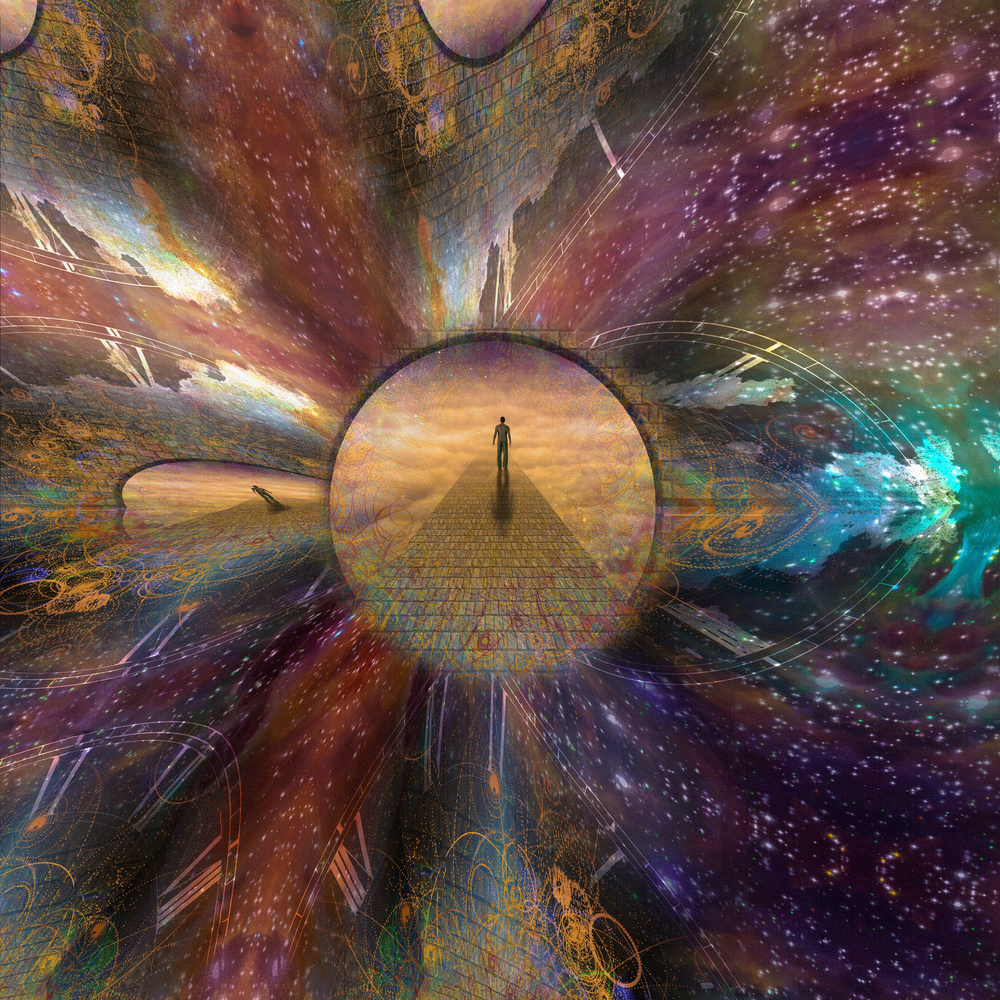 Now, if you don’t necessarily have a mood to work with, then here’s another suggestion. You can use the energy of your senses, only direct it inwardly.
Now, if you don’t necessarily have a mood to work with, then here’s another suggestion. You can use the energy of your senses, only direct it inwardly.
Typically, our senses are directed outwardly. Our senses – and our attention – are dispersed into a world of diversions and muted by lack of focus. These days our senses flow into televisions, IPads, cell phones, computers, computer games, magazines, talk radio, scrolling billboards, and a myriad other blinking-flashing distractions.
We see without looking; hear without listening; read without learning; and we even eat food without remembering the meal, much less actually tasting it; and it seems as though no one can get enough of any of it.
Through a willed act of introversion, we stop and contain the outward flow of sensation. Next that energy starts to intensify and expand inwardly. The senses then begin to work to relay information about our inner world.
You can try this if you catch yourself in the moment before you eat something you aren’t hungry for or turn on the television because you are bored. Again, the goal is to get to the raw energy of the desire to distract yourself.
Active Imagination. Engaging the Mental Imagery
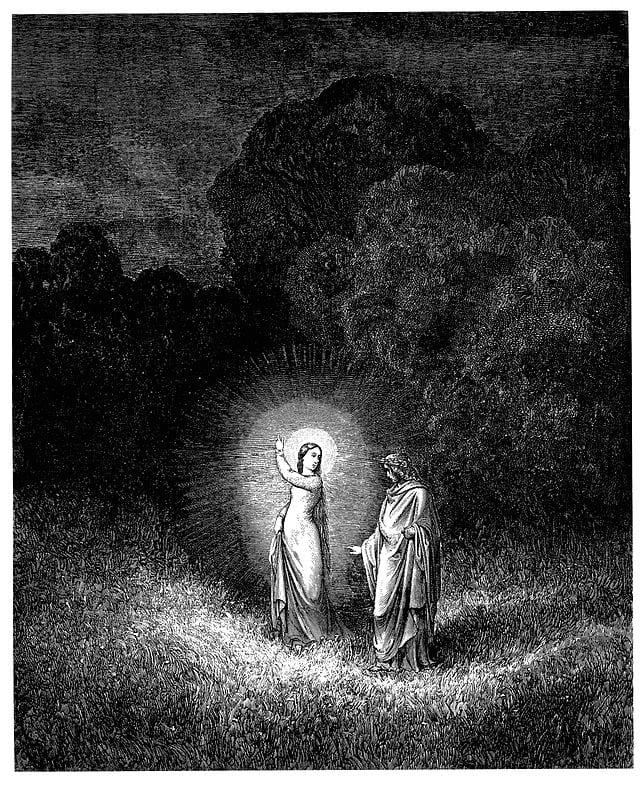 One of Jung’s most amazing Red Book discoveries was that this raw energy will form an image of itself. And more that that, it is an image you can engage in dialogue. Psyche speaks in imagery. This same power is behind dreams. Again, I always remind people that image was our first language. The gods were experiential images long before they were dogma and creed.
One of Jung’s most amazing Red Book discoveries was that this raw energy will form an image of itself. And more that that, it is an image you can engage in dialogue. Psyche speaks in imagery. This same power is behind dreams. Again, I always remind people that image was our first language. The gods were experiential images long before they were dogma and creed.
This whole process is the essence of what Jung called active imagination. It’s a willed descent into the dreamtime realm. Once there, you have to wait until the images form, and then, move and speak on their own. Jung gives a wonderful account on how to do this in Two Essays on Analytical Psychology in the section on Individuation. Anytime he uses the word affect, he is referring to the effects and feeling-toned state of your mood.
Engaging the Images in Active Imagination
one should cultivate the art of conversing with oneself in the setting provided by an affect, as though the affect itself were speaking without regard to our rational criticism. So long as the affect is speaking, criticism must be withheld. But once it has presented its case, we should begin criticizing as conscientiously as though a real person closely connected with us were our interlocutor. Nor should the matter rest there, but statement and answer must follow one another until a satisfactory end to the discussion is reached. Whether the result is satisfactory or not, only subjective feeling can decide. Any humbug is of course, quite useless.
Keep this quote in mind as you read the Red Book dialogues. You’ll see exactly what he means by all of it.
All of the images and dialogues in the Red Book formed of themselves. They came to life with Jung’s descent into his own darkness. If we want to find our own inner figures, we have to do the same thing.

 Philemon and other figures of my fantasies brought home to me the crucial insight that there are things in the psyche which I do not produce, but which produce themselves and have their own life.
Philemon and other figures of my fantasies brought home to me the crucial insight that there are things in the psyche which I do not produce, but which produce themselves and have their own life.
thank you for a wonderful series of articles that make jung’s ideas so clear and accessible
Did Jung develop Active Imagination after fellow Freudian student Herbert Silberer wrote about using the Hypnogogic state to access psychic material in a 1909 paper?
Thank you Jesamine, for a better explanation of Active Imagination than some have presented. There seems to be a parallel regarding the importance of ‘feeling’ to the ideas of Janov’s Primal Therapy, in that the feeling is the starting point.
Grateful..
Well I just experienced this crazy thing. I kept expressing my inner child wound shadows and been playing linking park songs. That made me vibrate and feel all the pain, shame, doubt, insecurity. In raw fullness.
normally I would end the day playing positive affirmations. But this time I wanted to surrender.
inwardly I spoke to my shadow every shadow I have is important! You are my path to wholeness and transformation.
I want to feel you and express yourself. I’m here now.
so I tried sleeping but that time I couldn’t so I played the the power of the subconscious mind audiobook.
that was the most interesting experience I’ve ever had.
i slept and would dream of being inside the mandala circle and i was whole. And I’d wake up ohh im just dreaming.
go back to sleep and different situations same thing im in a mandala circles being whole i felt whole.
then I’d wake up again and still have the same dream.
this happened 4 times. And I’m sure I didn’t sleep so deep because I kept waking to move position.
but that sleep made me change my whole being I felt so whole and songs would appear in my mind.
i had the urge to play miracle by Ellie Goulding. I played it listened to the song and actively read the lyrics.
while listening my mind body and soul would vibrate so much I felt like a purring sensation.
then I passed by a video on YouTube . The universe willl test you if you are ready.
that video looked so shiny so played it.
it told me the change is real and the universe will test you will you expand and be whole or will you shrink back?
that made me so sure that if I felt any fear, shame, insecurity all I need to know is I am whole.
so my friend called me to hang out. And we did.
I’ve had this wounds with him. So much projection and based my identity on our friendship.
id normally be in chasing validation loop.
but this time i surrendered.
since the universe is gonna test me why not now.
every part of me welcomed my shadow.
then the song would actively play in my mind
crawling in my skin.. these wounds they would not heal.. fear is how I fall. Confusing what is real.
this intense vibration on my mind body and soul felt so complete through the pain!
that was such a new vibration for me. When I completely surrendered.
this friend has triggered me to my father wound that led me to try and kill myself in the past.
I’ve been betrayed gaslighted and manipulated.
when I welcomed any shadow from within me I felt this intense vibration the intense fear! Insecurity. Shame. It vibrated in such a new way I have no words for it.
the songs really helped me transform that pain.
after that we all went home I saw dark figures that used to scare me and trigger me to be angry.
ohh that looks familiar. I’m here I welcome all shadows let’s get through this.
I did not forced it I just surrendered and remained present.
I was even moving along my room being active.
rthen face Les would appear in my peripheral view.
wow this is so vivid.
then suddenly all the moments where I truly felt love appeared. I could observe myself and I’d vibrate.
then I can suddenly see chapters.
i then could see the very first time I gazed and truly felt love for the first time.
i leaned those parts of me that I thought were gone has always been inside me all along.
this got me so excited wtf I asked ChatGPT what’s going on.
I was expecting shadows and it surprised me with something I didn’t expect.
then i had the urge to play the song Mandy more cry.
i Listen to it and was reading the lyrics.
all the times I repressed my anima it showed me how much it wanted to help me but I repressed it way to much
I could see all those moments and it was inside me all along.
these tears kept coming so much.
I expected shadow work and something else came! All the time I thought I had hallucinations it was my anima all along!!
the creativity the way it connected with me amazes me.
and today I just saw this is a thing! Wow I’ve been doing this shadow work with just me and YouTube videos.
i’m Curious about how to even have a stronger relationship with the self.
all I did here was surrendered.
the mere acceptance of being whole just focusing on inward welcoming any shadow
gave me this experience. This is something so new to me.
when I clinged to nothing everything came to me.
Thanks for sharing — it’s clear this was a powerful experience for you. We can certainly recognize the mandala dreams, shadow, and anima themes you describe. Such images often mark steps in a larger unfolding process rather than a finished state of wholeness. Active imagination means staying present with what arises and allowing the image to take form — then through dialogue, art, or reflection, finding how its message can be lived more consciously.